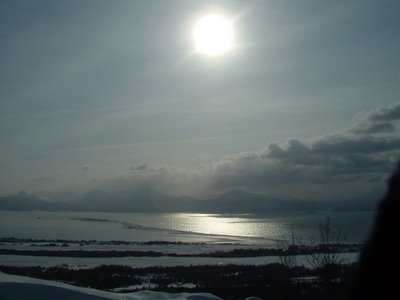 Date: Feb. 28
Date: Feb. 28Mileage: 18.4
February mileage: 433.3
Temperature upon departure: 10
A friend of mine is back in town after an extended trip home to Venezuela. She told us that the phrase her family uses to describe Alaska literally translates to "go to the end of the world, then take a left." (of course, it sounds much more alluring in Spanish.)
Today was a ride of subtle annoyances and short attention span. It was frosty out with a sharp, sustained wind (another friend informed me that the wind-chill factor was "minus 17, at least.") Lo these past few months, I've gotten pretty good at looking at the thermometer and knowing exactly what to wear, so I never felt chilled. But today conditions were just perfect for "cold headaches." You know, the kind you get when you suck down a Slurpee too fast? Yeah. You can get those cycling, too - especially if you're heading up a steep hill, right into the wind, and you start breathing too hard.
I rode an all-too-familiar route and completely zoned out. I probably wasn't pushing myself very hard at all, because I started thinking about writing projects from years ago that I'm curious to dredge up, and suddenly I was wheeling into my driveway. Have you ever done that in your car? Arrived at a destination only to realize you have no memory of the journey? Yeah, you can do that cycling, too.
My "camelbak injury" is still really bothering me, and I'm starting to wonder if it's something else (sustained muscle soreness in my lower left shoulder). As it is, I haven't carried a camelbak and therefore haven't had any water to drink on rides since the Susitna. But, what can you do? I've gone to see doctors about these strange injuries before. The best they've ever done is prescribe painkillers, so I guess I'll keep eating Ibuprofens.
I'm still watching the Iditarod Trail Invitational. Based on some of the checkpoint times these bikers are posting, I can see a lot of similarities to the Susitna 100 - conditions started out pretty good, (much colder, but good) so the leaders got through pretty fast. They're pushing on now to the last third of the 350-mile race. The bikers who were left behind, though, seem to be bogged down in conditions that quickly went to hell. One biker took nearly 36 hours just to clear 40 miles between the second and third checkpoints (and at last post was only 130 miles into an 1,100-mile slog.) Ug. It seems like racers are dropping out left and right, and I can only imagine what it must be like out there right now. But that's my problem. I can imagine. So I watch with fascinated empathy - and this dark (masochistic) side of myself even feels envy.







